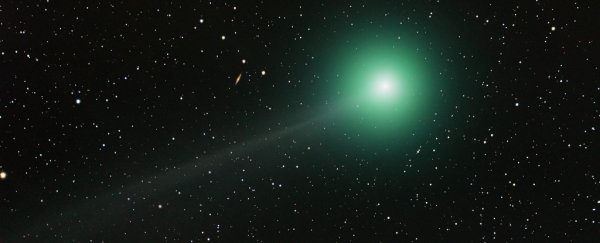It's been a big puzzle for more than two decades - if something emits X-rays, it's going to be very hot. But comets? They're balls of ice and rock, yet still emit X-rays. It's been a tricky one, but researchers think they have finally figured out why.
The discovery that comets emit X-rays is relatively recent. It was first observed in 1996, when the ROSAT spacecraft detected X-rays in the vicinity of Comet Hyakutake.
This observation has been attributed to something called 'charge exchange' - when strong positively-charged solar wind ions attracted to negatively-charged electrons from the neutral gas surrounding the comet.
Later, when observing comet LINEAR in 2000, NASA's Chandra X-ray observatory detected a strong X-ray signal from nitrogen and oxygen atoms that had lost most of their electrons.
Characteristic to this X-ray radiation is that it is generated on the side of the comet facing the Sun, where the interaction between the solar wind and the cometary atmosphere create a bow shock. And it grows much weaker as the comet moves away from the Sun, disappearing entirely at large distances.
It all seems to make good sense.
But, according to new research led by Bob Bingham of the UK Science & Technology Facilities Council, this charge exchange model isn't perfect - and his team has found a better one.
It's a little bit more complex though - all to do with something called Bremsstrahlung, or "braking radiation", the name for the electromagnetic radiation that occurs when a charged particle accelerates or decelerates after passing through the electric field of another charged particle.
If the energy of this encounter is high enough, the particles emit X-rays.
"To fit the data with the charge exchange model required careful atomic line selection, while bremsstrahlung was easy to fit," Bingham explained in an email to ScienceAlert.
"What is the role of the energetic particles since they will still radiate irrespective of charge exchange? If you take their distribution and feed it into the Bremsstrahlung formula, up comes the spectrum of radiation that is observed. It was determined that most of the X-ray radiation was due to Bremsstrahlung."
The research team's aim was to investigate how these energetic particles are produced at collisionless shocks, a type of shockwave that isn't produced by particle collisions, but plasma waves. And, indeed, cometary bow shocks are collisionless.
They designed an experiment to replicate the interaction between the solar wind and a comet at the LULI laser facility in France.
First, laser beams were fired at a plastic foil. The resulting explosion expelled a high-speed flow of ionised gas, or plasma, just like solar wind.
Waiting in the path of this flow, around one centimetre from the plastic foil, was a solid sphere - our experimental "comet".
When the plasma flow impacted with the sphere, plasma turbulence superheated electrons up-stream, resulting in X-ray emission - but only in the presence of a magnetic field.
So the experiment showed that the energetic electrons in collisionless shocks are produced by the acceleration of charged particles, and that these energetic electrons produced X-rays.
The Bremsstrahlung model even accounts for the high number of atoms stripped of their electrons observed around comets.
"The energetic electrons can easily ionise the atoms," Bingham said.
The experiment also demonstrated a possible solution to what is known as the injection problem, whereby strong shockwaves are expected to accelerate particles to very high energies - but those particles need to be fast enough to pass the shock in the first place.
Plasma turbulence, the team found, can provide a source of particles fast enough to overcome the injection problem.
"These experimental results are important as they provide direct laboratory evidence that objects moving through magnetized plasmas can be sites of electron acceleration," Bingham said in a statement.
"[It's] a very general situation in astrophysics that takes place not only in comets, but also in planetary magnetospheres, such as our own Earth, or even in supernova remnants, where the ejected material moves across the interstellar gas.
"The experiments also confirm theoretical models developed by the team."
The team's research has been published in the journal Nature Physics.
